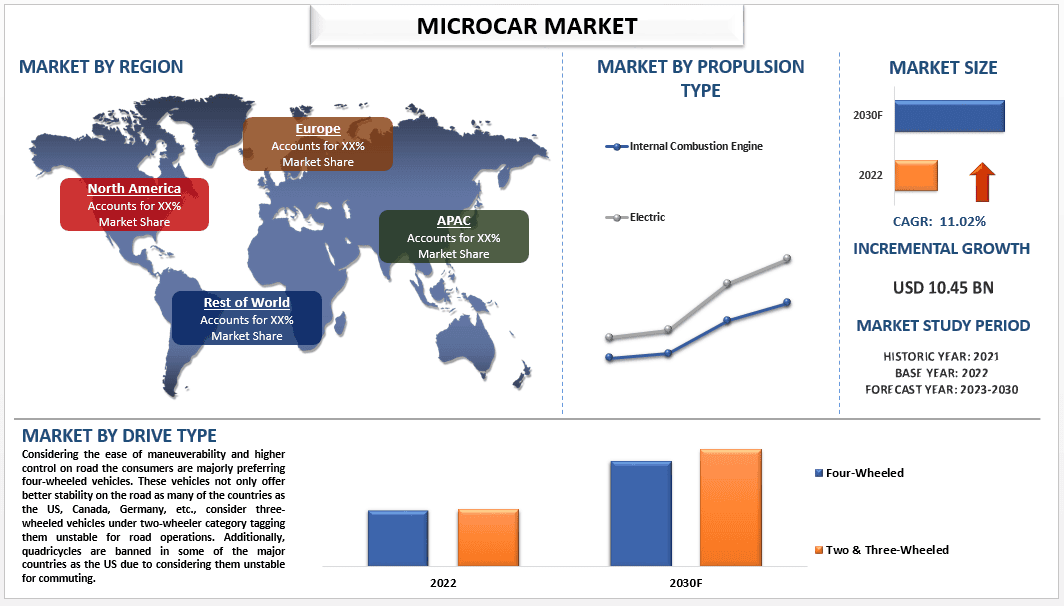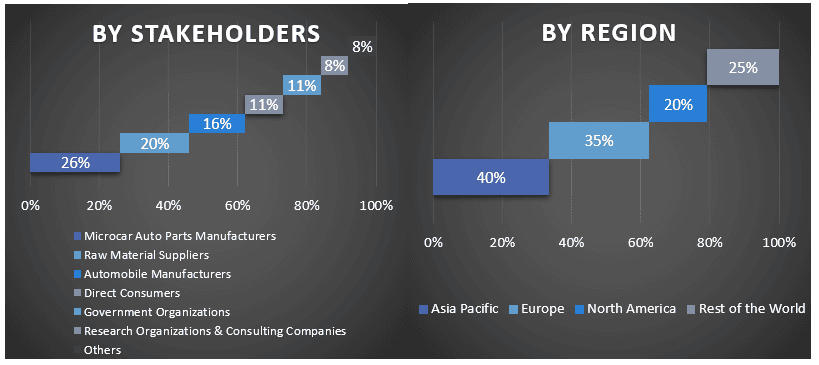- Home
- About Us
- Industry
- Services
- Reading
- Contact Us
Microcar Market: Current Analysis and Forecast (2023-2030)
Emphasis on Propulsion Type (Internal Combustion Engine, Electric), Drive Type (Four-Wheeled, Two & Three Wheeled); End-User (Commercial, Passenger); and Region/Country

The Microcar Market was valued at 4.53 billion in the year 2022 and is expected to grow at a steady rate of around 11.02 % during the forecast period (2023-2030), owing to the growing need for smaller vehicle coping with city traffic and reducing the operation cost of owning vehicle by individual customers and smaller families. Furthermore, Some of the factors attributed to the growth are the high demand for smaller cars among consumers due to higher traffic congestion in urban areas as well as the higher fuel economy of smaller cars, keeping operational costs in check. Additionally, parking space availability has also become scarce in most of the urban places across the world, which has forced consumers to opt for smaller alternatives to large cars.
In line with this, many automotive manufacturers have announced their plans to launch new microcars under sub-3-meter lengths apt for maneuvering in heavy traffic congestions. For instance, in 2022, Renault announced the launch of its new electric quadricycle Mobilize Duo. The model is an update to the Renault Twizy.
Additionally, various government policies have also promoted the adoption of microcars as they are more sustainable mode of transportation..
Some of the major players operating in the market include Group PSA, Smart (Mercedes Benz), Toyota Motor Company, Honda Motor Company, General Motors, PMV Electric, LIGER Group, Geely, Micro Mobility Systems (Microlino), Group Renault S.A., Nissan Motors Co. Ltd. Etc. Several M&As along with partnerships have been undertaken by these players to facilitate customers with hi-tech and innovative products/technologies.
Insights Presented in the Report
“Amongst Propulsion Type, the Electric Microcar Segment Held Majority of the Market Share in the Year 2022.”
Based on the propulsion, the market is segmented into internal combustion-based and electric. Of these, internal combustion engines have held a sizeable market share across the globe. The ease of refueling, as well as the lower cost of conventional engines compared to electric powertrains, has assisted the segment in holding a sizeable market share. However, with the declining cost of the lithium-ion batteries and achieving the economies of scale in the electric powertrain many of the new microcar models devising electric powertrain have embarked into the microcar market. This is one of the major shifts that would steer the electric powertrain-based microcar’s market growth and help the segment hold a dominant market share in the forecast years, i.e., 2023-2030.
Internal Combustion engine-based microcars have long dominated the market due to the ease of producing small-sized engines which are fuel efficient. Additionally, the electric powertrain systems have started becoming widespread in the recent years which have helped the segment to grow its share. Smaller conventional engine models have also provided ease of repair, easy availability of spare parts, and easy refueling alleviating range anxiety. Due to which a large swathe of customers have opted for particular models of microcars using internal combustion engines.
“Amongst Drive Type, the Four-Wheeled holds the Majority Share of the Market.”
The Global Microcar market is segmented by four-wheeled and two and three wheeled vehicles in terms of drive type. Considering the ease of maneuverability and higher control on road the consumers are majorly preferring four-wheeled vehicles. These vehicles not only offer better stability on the road as many of the countries as the US, Canada, Germany, etc., consider three-wheeled vehicles under two-wheeler category tagging them unstable for road operations. Additionally, quadricycles are banned in some of the major countries as the US due to considering them unstable for commuting. Additionally, people are conditioned to buy four-wheeled vehicles over three or two wheeled vehicles due to their appearance of cars that has proven to be conducive for the demand growth of respective segment. Four-Wheeled microcars have held major market share across the globe and is anticipated to further increase their market share in the forecasted years. Some of the factors that have attributed to the growth of the segment is higher inclination of the customers towards opting for four wheelers due to their higher stability, greater load carrying capacity, better ground clearance, their appearance as a car, better passenger carrying space, etc. Additionally, microcars are seen as a smaller alternative to the larger SUVs, Sedans and Hatchbacks due to which the customer are more inclined towards opting for similar four-wheeled alternatives in smaller size for easier handling and moving through heavy traffic situations.
Microcar Market Report Coverage
Report Attribute | Details |
Base year | 2022 |
Forecast period | 2023-2030 |
Growth momentum | Accelerate at a CAGR of 11.02% |
Market size 2022 | USD 4.53 billion |
Regional analysis | North America, Europe, APAC, Rest of the World |
Major contributing region | Asia Pacific is the fastest-growing market in the Microcar Market |
Key countries covered | The U.S., Canada, Germany, The U.K., France, Italy, China, India, Japan |
Companies profiled | Group PSA, Smart (Mercedes Benz), Toyota Motor Company, Honda Motor Company, General Motors, PMV Electric, LIGER Group, Geely, Micro Mobility Systems (Microlino), Group Renault S.A., Nissan Motors Co. Ltd. Etc. |
Report Scope | Market Trends, Drivers, and Restraints; Revenue Estimation and Forecast; Segmentation Analysis; Impact of COVID-19; Demand and Supply Side Analysis; Competitive Landscape; Company Profiling |
Segments Covered | By Propulsion Type; By Drive Type; By End-Use; By Region/Country |
“Asia Pacific is anticipated to be one of the Fastest Growing Market for Microcars across the Globe during the Forecast Period (2023-2030).”
Asia Pacific is emerging as one of the fastest-growing markets for automotive and automotive-related products. Asia-Pacific is home to some of the fastest-growing economies, such as China, India, Indonesia, South Korea, etc. These countries have been witnessing emergence due to the growth of population as well as economic growth that has allowed consumers to look towards passenger cars, especially in the affordable segment. Among these countries, there is a high demand for small-budget-friendly cars that would be crucial for the adoption for microcars in the Asia-pacific region. India being one of the major markets in the region has witnessed a high demand for smaller cars. According to the Spinny an online car selling platforms in India top 2 most selling car makers were Suzuki and Hyundai which have a major focus on the hatchback small cars. This shows a major potential for smaller cars in the countries. Additionally, Japan is another country that has a culture for smaller cars where companies such as Nissan, Kei, Daihatsu, Honda, Mitsubishi, Mazda, etc., offer Kei Cars. These trends, coupled with a rising number of automotive enthusiasts, contribute to the growing market of Microcars in the APAC region.
Reasons to buy this report:
- The study includes market sizing and forecasting analysis validated by authenticated key industry experts.
- The report presents a quick review of overall industry performance at one glance.
- The report covers an in-depth analysis of prominent industry peers with a primary focus on key business financials, product portfolios, expansion strategies, and recent developments.
- Detailed examination of drivers, restraints, key trends, and opportunities prevailing in the industry.
- The study comprehensively covers the market across different segments.
- Deep dive regional level analysis of the industry.
Customization Options:
The global Microcar market can further be customized as per the requirement or any other market segment. Besides this, UMI understands that you may have your own business needs, hence feel free to contact us to get a report that completely suits your requirements.
Table of Content
Research Methodology for the Microcar Market Analysis (2023-2030)
Analyzing the historical market, estimating the current market, and forecasting the future market of the global Microcar market were the three major steps undertaken to create and analyze the adoption of Microcar in major regions globally. Exhaustive secondary research was conducted to collect the historical market numbers and estimate the current market size. Secondly, to validate these insights, numerous findings and assumptions were taken into consideration. Moreover, exhaustive primary interviews were also conducted, with industry experts across the value chain of the global Microcar market. Post assumption and validation of market numbers through primary interviews, we employed a top-down/bottom-up approach to forecasting the complete market size. Thereafter, market breakdown and data triangulation methods were adopted to estimate and analyze the market size of segments and sub-segments of the industry pertains to. Detailed methodology is explained below:
Analysis of Historical Market Size
Step 1: In-Depth Study of Secondary Sources:
A detailed secondary study was conducted to obtain the historical market size of the Microcar market through company internal sources such as annual reports & financial statements, performance presentations, press releases, etc., and external sources including journals, news & articles, government publications, competitor publications, sector reports, third-party database, and other credible publications.
Step 2: Market Segmentation:
After obtaining the historical market size of the Microcar market, we conducted a detailed secondary analysis to gather historical market insights and share for different segments & sub-segments for major regions. Major segments are included in the report as by propulsion, by drive type, and end-user. Further country-level analyses were conducted to evaluate the overall adoption of testing models in that region.
Step 3: Factor Analysis:
After acquiring the historical market size of different segments and sub-segments, we conducted a detailed factor analysis to estimate the current market size of the Microcar market. Further, we conducted factor analysis using dependent and independent variables such as by propulsion, by drive type, and end-user of the Microcar market. A thorough analysis was conducted for demand and supply-side scenarios considering top partnerships, mergers and acquisitions, business expansion, and product launches in the Microcar market sector across the globe.
Current Market Size Estimate & Forecast
Current Market Sizing: Based on actionable insights from the above 3 steps, we arrived at the current market size, key players in the global Microcar market, and market shares of the segments. All the required percentage shares split and market breakdowns were determined using the above-mentioned secondary approach and were verified through primary interviews.
Estimation & Forecasting: For market estimation and forecast, weights were assigned to different factors including drivers & trends, restraints, and opportunities available for the stakeholders. After analyzing these factors, relevant forecasting techniques i.e., the top-down/bottom-up approach were applied to arrive at the market forecast for 2030 for different segments and sub-segments across the major markets globally. The research methodology adopted to estimate the market size encompasses:
- The industry’s market size, in terms of revenue (USD) and the adoption rate of the Microcar market across the major markets domestically
- All percentage shares, splits, and breakdowns of market segments and sub-segments
- Key players in the global Microcar market in terms of products offered. Also, the growth strategies adopted by these players to compete in the fast-growing market.
Market Size and Share Validation
Primary Research: In-depth interviews were conducted with the Key Opinion Leaders (KOLs) including Top Level Executives (CXO/VPs, Sales Head, Marketing Head, Operational Head, Regional Head, Country Head, etc.) across major regions. Primary research findings were then summarized, and statistical analysis was performed to prove the stated hypothesis. Inputs from primary research were consolidated with secondary findings, hence turning information into actionable insights.
Split of Primary Participants in Different Regions

Market Engineering
The data triangulation technique was employed to complete the overall market estimation and to arrive at precise statistical numbers for each segment and sub-segment of the global Microcar market. data was split into several segments & sub-segments after studying various parameters and trends in the areas of the by propulsion, by drive type, and end-user in the global Microcar market.
The main objective of the Global Microcar Market Study
The current & future market trends of the global Microcar market were pinpointed in the study. Investors can gain strategic insights to base their discretion for investments on the qualitative and quantitative analysis performed in the study. Current and future market trends determined the overall attractiveness of the market at a regional level, providing a platform for the industrial participant to exploit the untapped market to benefit from a first-mover advantage. Other quantitative goals of the studies include:
- Analyze the current and forecast market size of the Microcar market in terms of value (USD). Also, analyze the current and forecast market size of different segments and sub-segments.
- Segments in the study include areas of by propulsion, by drive type, and end-user.
- Define and analyze the regulatory framework for the Microcar
- Analyze the value chain involved with the presence of various intermediaries, along with analyzing customer and competitor behaviors of the industry
- Analyze the current and forecast market size of the Microcar market for the major region
- Major countries of regions studied in the report include Asia Pacific, Europe, North America, and the Rest of the World
- Company profiles of the Microcar market and the growth strategies adopted by the market players to sustain in the fast-growing market
- Deep dive regional level analysis of the industry
Frequently Asked Questions FAQs
Q1: What is the current market size and growth potential of the global Microcar Market?
Q2: What are the driving factors for the growth of the global Microcar Market?
Q3: Which segment has the largest share of the global Microcar Market by Propulsion Type?
Q4: What are the emerging technologies and trends in the global Microcar Market?
Q5: Which region will dominate the global Microcar Market?
Q6: Who are the key players operating in the global Microcar Market?
Related Reports
Customers who bought this item also bought










